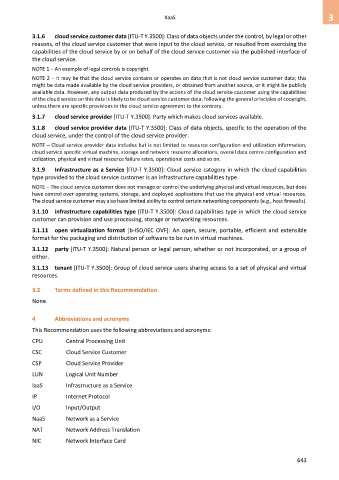Page 651 - Cloud computing: From paradigm to operation
P. 651
XaaS 3
3.1.6 cloud service customer data [ITU-T Y.3500]: Class of data objects under the control, by legal or other
reasons, of the cloud service customer that were input to the cloud service, or resulted from exercising the
capabilities of the cloud service by or on behalf of the cloud service customer via the published interface of
the cloud service.
NOTE 1 – An example of legal controls is copyright.
NOTE 2 – It may be that the cloud service contains or operates on data that is not cloud service customer data; this
might be data made available by the cloud service providers, or obtained from another source, or it might be publicly
available data. However, any output data produced by the actions of the cloud service customer using the capabilities
of the cloud service on this data is likely to be cloud service customer data, following the general principles of copyright,
unless there are specific provisions in the cloud service agreement to the contrary.
3.1.7 cloud service provider [ITU-T Y.3500]: Party which makes cloud services available.
3.1.8 cloud service provider data [ITU-T Y.3500]: Class of data objects, specific to the operation of the
cloud service, under the control of the cloud service provider.
NOTE – Cloud service provider data includes but is not limited to resource configuration and utilization information,
cloud service specific virtual machine, storage and network resource allocations, overall data centre configuration and
utilization, physical and virtual resource failure rates, operational costs and so on.
3.1.9 Infrastructure as a Service [ITU-T Y.3500]: Cloud service category in which the cloud capabilities
type provided to the cloud service customer is an infrastructure capabilities type.
NOTE – The cloud service customer does not manage or control the underlying physical and virtual resources, but does
have control over operating systems, storage, and deployed applications that use the physical and virtual resources.
The cloud service customer may also have limited ability to control certain networking components (e.g., host firewalls).
3.1.10 infrastructure capabilities type [ITU-T Y.3500]: Cloud capabilities type in which the cloud service
customer can provision and use processing, storage or networking resources.
3.1.11 open virtualization format [b-ISO/IEC OVF]: An open, secure, portable, efficient and extensible
format for the packaging and distribution of software to be run in virtual machines.
3.1.12 party [ITU-T Y.3500]: Natural person or legal person, whether or not incorporated, or a group of
either.
3.1.13 tenant [ITU-T Y.3500]: Group of cloud service users sharing access to a set of physical and virtual
resources.
3.2 Terms defined in this Recommendation
None.
4 Abbreviations and acronyms
This Recommendation uses the following abbreviations and acronyms:
CPU Central Processing Unit
CSC Cloud Service Customer
CSP Cloud Service Provider
LUN Logical Unit Number
IaaS Infrastructure as a Service
IP Internet Protocol
I/O Input/Output
NaaS Network as a Service
NAT Network Address Translation
NIC Network Interface Card
643

